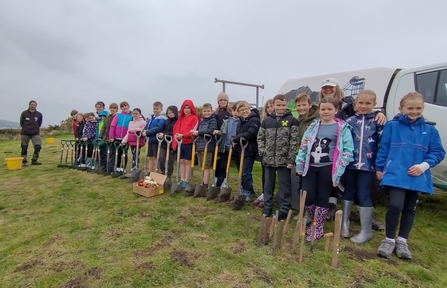
St Bees Village Primary School planted wildflowers at the National Trust's Haig Grasslands, Whitehaven, for The Big Buzz © Cumbria Wildlife Trust

St Bees Village Primary School planted wildflowers at the National Trust's Haig Grasslands, Whitehaven, for The Big Buzz © Cumbria Wildlife Trust
Over 1,000 people took part in a week-long wildflower planting community effort recently, to help Cumbria’s pollinating insects. One hundred community groups signed up for The Big Plant (1-8 May), the latest initiative from Cumbria Wildlife Trust’s Get Cumbria Buzzing project, to celebrate and help save our precious wild pollinators.
From primary schools to community centres, from allotments to hospices, a huge range of local community groups took part in The Big Plant, including St Bees Village Primary School, Christchurch Allonby and Food Carlisle. In total, the 100 community groups planted an amazing 15,000 plug plants, which had been grown at Cumbria Wildlife Trust’s Gosling Sike wildflower nursery. The plants were all grown pesticide-free and peat-free, from native, Cumbria-sourced wildflower seed. The groups also planted total of 20kg of seed, collected from Cumbria’s wildflower meadows.
The wildflowers they planted are all great for wild pollinators, and included red clover, oxeye daisy, black knapweed, meadow cranesbill, wild carrot, meadow buttercup, bird’s-foot trefoil, lady’s bedstraw, yarrow, ragged robin, viper’s-bugloss, selfheal and autumn hawkbit.
Carolyn Postlethwaite, Get Cumbria Buzzing Project Officer, said:
“I was blown away at the amazing response we had to The Big Plant – thank you so much to all 100 community groups for signing up and for their fantastic planting work. The Big Plant was all about empowering local community groups to create their own beautiful wildflower areas, for local people and for wild pollinators. The communities of north and north-west Cumbria have shouted loud and clear that they want to support direct action for pollinators across the region, by taking part in The Big Plant. It shows how much people want to make a difference in their own community, to help nature’s recovery.”
Carolyn explains why pollinating insects need our help: “Wild pollinators are incredibly important – did you know around 1/3 of the food we eat relies on pollinators? Sadly, they are struggling. More than half of UK bee, butterfly and moth species have declined in the past 50 years and 30 species of bees face extinction. Over the last 75 years, the UK has lost 97% of our flower rich meadows, which means we’re losing the flower-rich, wild spaces that support wild insect pollinators.”
“But local actions really can make a big difference to local pollinators. We don’t necessarily need to create big nature reserves in order to see changes to local pollinator populations! By creating small-scale areas where wildflowers can thrive, whether it’s a window box, a back yard or a roadside verge, we can start to see the benefits to local pollinator populations, from changes at a very local level.”
Find out more here Get Cumbria Buzzing or check the Facebook and twitter posts from groups who took part at #TheBigPlant
Since 2019 Cumbria Wildlife Trust has been the home of Get Cumbria Buzzing. This partnership project was set up to halt and reverse the alarming decline in wild pollinators across north and west Cumbria, by restoring wild spaces and wildflowers for pollinators.
Get Cumbria Buzzing is funded by National Lottery Heritage Fund, National Highways, and other funders. Partners include: Allerdale Borough Council, Buglife, Butterfly Conservation, Copeland Borough Council, Cumbria Biodiversity Data Centre, Florence Arts Centre, Highways England, National Trust, Solway Coast AONB and Workington Nature Partnership.

Using money raised by the National Lottery, we Inspire, lead and resource the UK’s heritage to create positive and lasting change for people and communities, now and in the future. www.heritagefund.org.uk.
Follow @HeritageFundUK on Twitter, Facebook and Instagram and use #NationalLotteryHeritageFund
Since The National Lottery began in 1994, National Lottery players have raised over £43 billion for projects and more than 635,000 grants have been awarded across the UK.